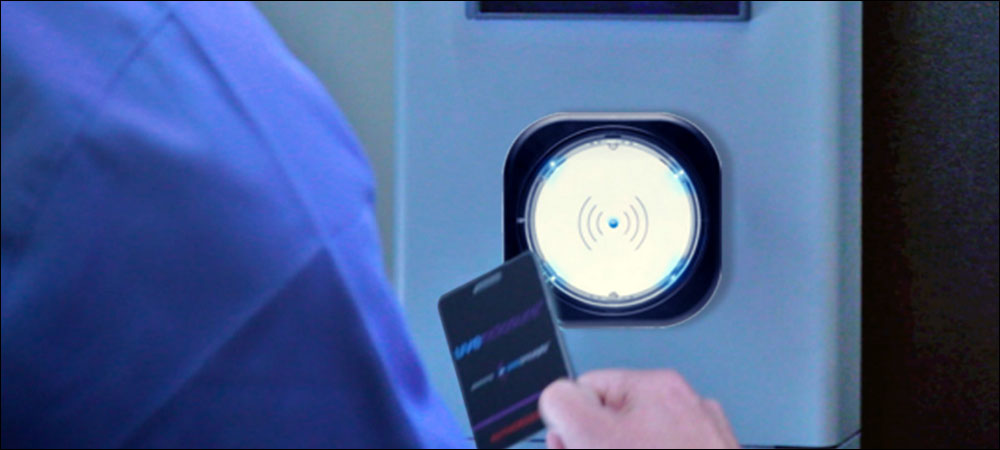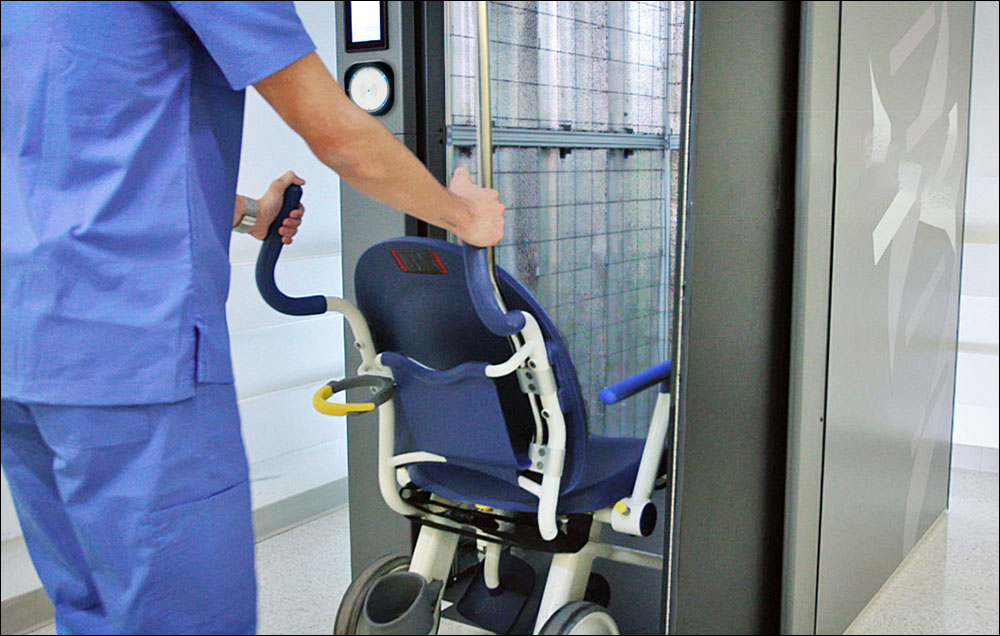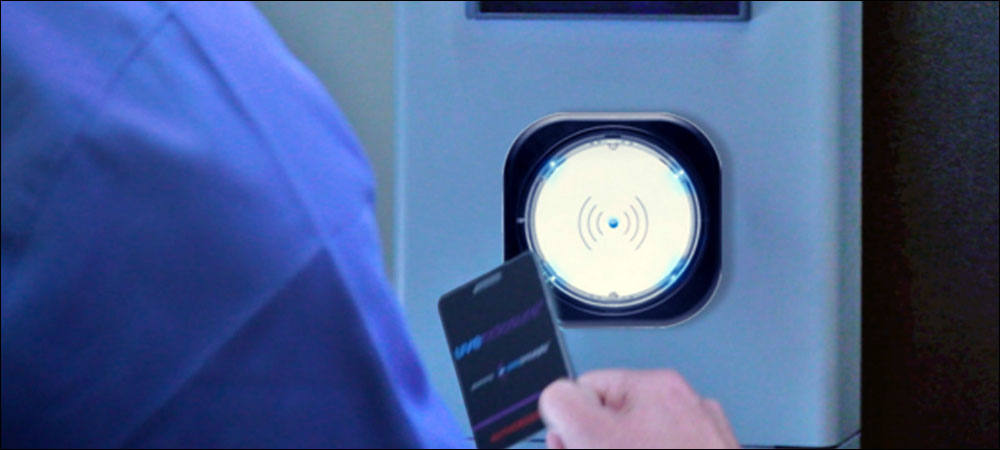Multiple hospitals and other healthcare facilities have been deploying HF RFID technology to address patient security, medication tracking and equipment sanitation, in order to ensure a safe environment for patient care. Serving this demand, technology company ELATEC is providing solutions to help companies identify healthcare workers, patients, medications and assets. The goal, the company reports, is to ensure the proper handling and dispensing of products, equipment or patient services, and to protect access to patient electronic records.
The solutions being used by ELATEC’s customers and solution providers include RFID-enabled carts to identify healthcare workers and secure what happens at a patient’s bedside. Additionally, the company supports multimedia terminals in each patient room that leverage an RFID reader-writer to identify a patient or healthcare provider, along with RFID-based identification of authorized parties for the use of an ultraviolet (UV) disinfection system at hospitals. At the center of these solutions is ELATEC’s TWN4 series passive 13.56 MHz HF RFID readers, compliant with the ISO 15693 standard.

One example is UV-Concepts‘ system, launched in January 2020, that supplements the cleaning and disinfecting process for equipment in hospitals or other facilities. The units incorporate the ELATEC readers to confirm the identity of each user who employs the technology to clean equipment. Each tag read creates a digital record of an event. UV-Concepts provides an enclosed UV-radiating device, known as an ultraviolet enclosure (UVE), that is being used at academic and community hospitals, as well as at U.S. government-operated medical centers, according to Jeremy Starkweather, U-Concepts’ co-founder and CEO. Since the startup was launched, it has installed its system at approximately 20 sites, he reports.
“The use of our technology is an essential improvement to the standard operating procedures for the cleaning and disinfecting of equipment in the healthcare environment,” Starkweather says. UV lights are effective at killing microorganisms within the UVE unit, but the system requires that those who use the equipment be authorized and clearly identified. Therefore, the UVE comes with a built-in RFID badge reader. Individuals first bring an item, such as wheelchair, to the UVE for disinfection. They carry an HF RFID badge linked to their identity, which they tap near the reader. If they are authorized to use the machine, it will release the lock and allow the wheelchair to be placed inside.

The same badge must be tapped a second time to close the door and turn on the disinfection system, which initiates a six-second cycle. This ensures that the process has been accomplished by a trained user. If the individual is not authorized to use the machine, it will not operate. The UVE system also employs Bluetooth tags attached to equipment, which can be recognized by a beacon inside the unit. Thus, the cloud-based management software knows which operator has used the equipment, thanks to the RFID data, as well as which equipment has been sanitized according to the Bluetooth transmission.
ELATEC has been providing systems to secure patient data for other solutions as well, according to Sean Houchin, the company’s product manager. In one such use case, an RFID card carried by a healthcare provider uniquely identifies workers as they go about providing patient care. In some cases, employees might use a hospital room cart carrying medications. Hospitals employ a small handheld barcode scanner that incorporates an RFID reader tethered to the cart. When treating patients at their bedside, a worker can read the HF RFID badge to identify themselves, then scan the patient’s wristband. If narcotics are being administered, the cart can remain locked until the patient and the healthcare worker have both been identified.

Jeremy Starkweather
Once authorized, employees can be provided with access to the medications in the cart. By reading the tag on the patient’s wristband, hospital personnel can clearly identify that the patient to whom they are tending is the person to whom they should be dispensing medication. Software can display patient records, and the provider can make sure the drug they are about to dispense matches the one prescribed. The software can display information about the appropriate dosage level, Houchin says, and the collected data can be used to manage inventory levels and trigger billing.
In addition, the system can manage patient records, including printed materials, to ensure the hospital stays within HIPAA compliance. If a doctor, nurse or administrator needs to have physical documentation for a patient, they can employ ELATEC’s technology, with an HF reader integrated into the printer, to identify an individual before releasing the document to be printed. Only after an individual presents an RFID-enabled employee badge (or mobile-credentialed smartphone) within range of the integrated reader will the document print. In that way, the hospital can ensure that only authorized individuals access documentation.
In laboratories, Houchin says, ELATEC’s technology is being used to track patient samples, to make sure they are never mishandled or lost. In this case, an RFID tag is attached to the sample or vial, and when that sample is inserted into a diagnostic machine, an RFID reader connected to that device reads the tag, confirms the sample’s identity and can display necessary information. Data captured from that event can be stored in the hospital’s software to confirm what diagnostic testing took place, as well as when and by whom. “Tracking laboratory samples has become a really big demand,” he states, “that we’re seeing a lot more of right now.”

Sean Houchin
ELATEC readers support multimedia terminals that can be used by patients to access entertainment and services while they are staying at a hospital. The bedside touchscreen terminal allows patients to place orders from a cafeteria or vending machine, as well as access television or Internet services. Both patients and hospital personnel can use the terminal by first identifying themselves with their RFID badge or wristband. While patients can access entertainment or services, physicians can gain bedside digital patient information.
The ultraviolet sanitation technology is gaining more interest from healthcare facilities to reduce the risk of enabling transmission of health associated infections (HAIs) via contaminated surfaces. Sole reliance on the manual cleaning and disinfecting processes, fails to address this risk, Starkweather argues. Medical equipment can be contaminated with deadly pathogens, he explains, at rates as high as 30 to 50 percent at many hospitals. Due to such high contamination rates, healthcare facilities have been approaching the technology company for an added layer of effectiveness.
Claire Swedberg has been covering RFID technology for RFID Journal since 2005. She also contributes to magazines on subjects such as electrical installations and alternative energy. She is the author of five historical nonfiction books, and teaches an adult writing class.
Exhibitors at RFID Journal LIVE! 2022 offer solutions for tagging healthcare assets. To learn more, visit the event’s website.


